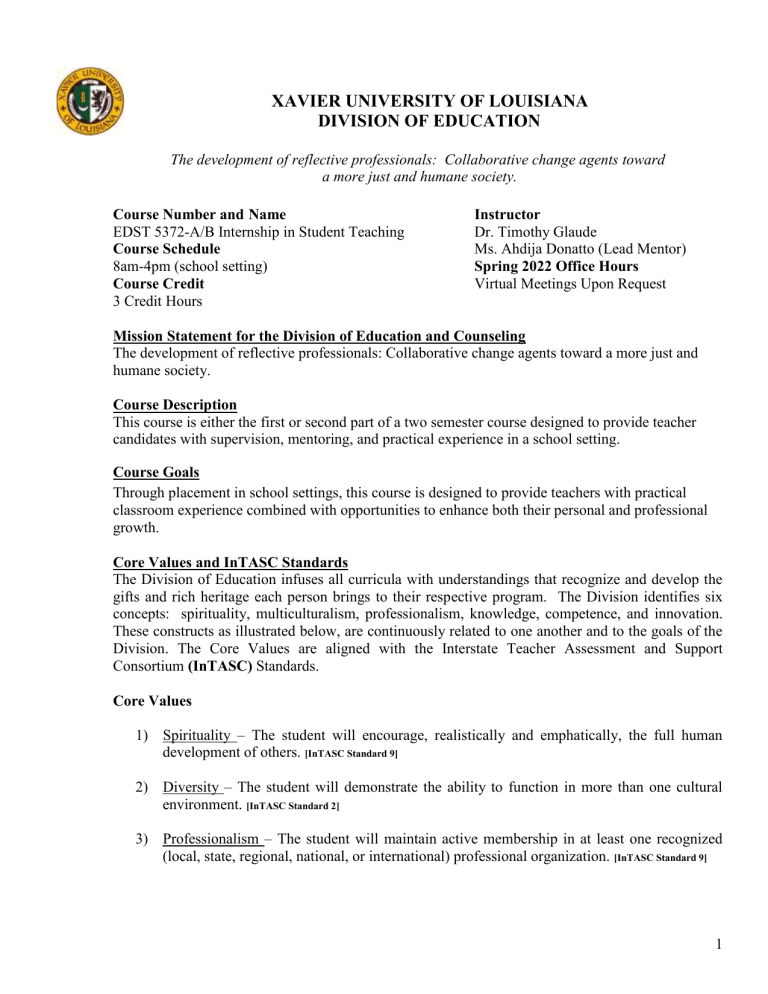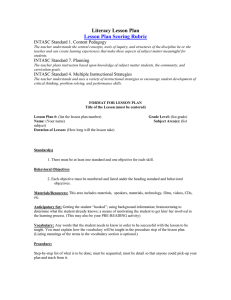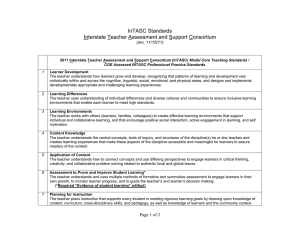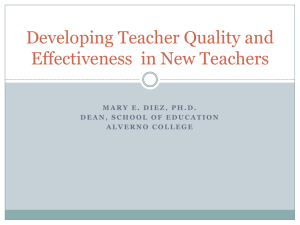
XAVIER UNIVERSITY OF LOUISIANA DIVISION OF EDUCATION The development of reflective professionals: Collaborative change agents toward a more just and humane society. Course Number and Name EDST 5372-A/B Internship in Student Teaching Course Schedule 8am-4pm (school setting) Course Credit 3 Credit Hours Instructor Dr. Timothy Glaude Ms. Ahdija Donatto (Lead Mentor) Spring 2022 Office Hours Virtual Meetings Upon Request Mission Statement for the Division of Education and Counseling The development of reflective professionals: Collaborative change agents toward a more just and humane society. Course Description This course is either the first or second part of a two semester course designed to provide teacher candidates with supervision, mentoring, and practical experience in a school setting. Course Goals Through placement in school settings, this course is designed to provide teachers with practical classroom experience combined with opportunities to enhance both their personal and professional growth. Core Values and InTASC Standards The Division of Education infuses all curricula with understandings that recognize and develop the gifts and rich heritage each person brings to their respective program. The Division identifies six concepts: spirituality, multiculturalism, professionalism, knowledge, competence, and innovation. These constructs as illustrated below, are continuously related to one another and to the goals of the Division. The Core Values are aligned with the Interstate Teacher Assessment and Support Consortium (InTASC) Standards. Core Values 1) Spirituality – The student will encourage, realistically and emphatically, the full human development of others. [InTASC Standard 9] 2) Diversity – The student will demonstrate the ability to function in more than one cultural environment. [InTASC Standard 2] 3) Professionalism – The student will maintain active membership in at least one recognized (local, state, regional, national, or international) professional organization. [InTASC Standard 9] 1 4) Inquiry – The student will use appropriate learning strategies to enhance learning and development. [InTASC Standard 5] [InTASC Standard 8] 5) Competency – The student will demonstrate the ability to keep accurate and professional records of classroom assessments. [InTASC Standard 6] 6) Innovation – The student will apply technology to facilitate a variety of effective assessment and evaluation strategies. [InTASC Standard 3] [InTASC Standard 7] Copy and paste the link to review the InTASC Standards, which are also included in the syllabus. https://www.doe.in.gov/sites/default/files/licensing/intasc.pdf Copy and paste the link to review the LA-Compass Performance Evaluation Rubric for Teachers, which are also included in the syllabus. https://www.louisianabelieves.com/docs/default-source/key-compass-resources/2014-2015-compassteacher-rubric.pdf?sfvrsn=98f59ba4_14 InTASC Standards and Learning Outcomes The learning outcomes (what teachers will understand, have knowledge of, and be able to do) are closely aligned with the identified InTASC Standards. A complete list of the standards is below. InTASC Standards The Learner and Learning Standard 1: Learner Development—The teacher understands how learners grow and develop, recognizing that patterns of learning and development vary individually within and across the cognitive, linguistic, social, emotional, and physical areas, and designs and implements developmentally appropriate and challenging learning experiences. Standard 2: Learning Differences—The teacher uses understanding of individual differences and diverse cultures and communities to ensure inclusive learning environments that enable each learner to meet high standards. Standard 3: Learning Environments—The teacher works with others to create environments that support individual and collaborative learning, and that encourage positive social interaction, active engagement in learning, and self-motivation. Content Standard 4: Content Knowledge—The teacher understands the central concepts, tools of inquiry, and structures of the discipline(s) he or she teaches and creates learning experiences that make the discipline accessible and meaningful for learners to assure mastery of the content. 2 Standard 5: Application of Content—The teacher understands how to connect concepts and use differing perspectives to engage learners in critical thinking, creativity, and collaborative problem solving related to authentic local and global issues. Instructional Practice Standard 6: Assessment—The teacher understands and uses multiple methods of assessment to engage learners in their own growth, to monitor learner progress, and to guide the teacher’s and learner’s decision making. Standard 7: Planning for Instruction—The teacher plans instruction that supports every student in meeting rigorous learning goals by drawing upon knowledge of content areas, curriculum, crossdisciplinary skills, and pedagogy, as well as knowledge of learners and the community context. Standard 8: Instructional Strategies—The teacher understands and uses a variety of instructional strategies to encourage learners to develop deep understanding of content areas and their connections, and to build skills to apply knowledge in meaningful ways. Professional Responsibility Standard 9: Professional Learning and Ethical Practice—The teacher engages in ongoing professional learning and uses evidence to continually evaluate his/her practice, particularly the effects of his/her choices and actions on others (learners, families, other professionals, and the community), and adapts practice to meet the needs of each learner. Standard 10: Leadership and Collaboration—The teacher seeks appropriate leadership roles and opportunities to take responsibility for student learning, to collaborate with learners, families, colleagues, other school professionals, and community members to ensure learner growth, and to advance the profession. CLASS MEASURES FRAMEWORK TO GUIDE EDUCATION TEACHER PREPARATION https://www.classmeasures.com/ With the goal of improving student learning, Class Measures reviews teacher preparation programs to determine how the programs can expand their promising practices and address areas of improvement. Domain 1: Quality of Recruitment and Selection Context and Rationale: This domain addresses the teacher preparation provider’s responsibility to recruit and select candidates who show potential for the teaching profession and the current regional educational context. Indicator 1.1: To what extent do the selection and recruitment criteria and practices result in candidates who show potential for success in the teaching profession? 3 Indicator 1.2: To what extent is there convincing evidence that recruitment and selection processes result in candidate cohorts that represent the students of the region? Domain 2: Quality of Content Knowledge and Teaching Methods Context and Rationale: This domain focuses on how effectively the program ensures teacher candidates acquire content knowledge and the key teaching methods and skills needed to grow students by one academic year or meet IEP goals. Indicator 2.1: To what extent does the provider prepare candidates to teach students to write and to read utilizing the five essential components of reading instruction? Indicator 2.2: To what extent does the provider ensure that all candidates master the content knowledge and content pedagogy needed to effectively grow students by one academic year or meet IEP goals? Indicator 2.3: To what extent does the provider ensure teacher candidates practice and implement effective planning for instruction utilizing high‐quality curricular materials and practice and implement effective teaching skills* needed to grow students by one academic year or meet IEP goals? Domain 3: Quality of Feedback and Candidate Performance Context and Rationale: This domain focuses on how effectively the program provides feedback to candidates within their residency placements. It also assesses how well program supervisors use observation and feedback data to inform individual goal tracking and interventions to candidates in the field. Indicator 3.1: To what extent does the program utilize a process for written and oral feedback that is grounded in PK-12 student learning and includes measurable growth goals for candidates? Indicator 3.2: To what extent does the observation and feedback process result in improvement in the quality of student learning in the K‐12 setting? Domain 4: Quality of Continuous Improvement Process Context and Rationale: This domain examines how the program collects and utilizes data, and works with school system partners, to continually improve the quality of the teacher preparation program. Indicator 4.1: To what extent do program leaders and faculty systematically collect and collate high‐quality* data to facilitate continuous program improvement? Indicator 4.2: To what extent do program leadership, faculty, partner district and school leaders, and mentor teachers engage in continuous improvement planning? LA-Compass Domains Domain 1: Planning and Preparation Outcomes must refer to what students will learn, not what they will do, and must permit viable methods of assessment. 4 Domain 2: Classroom Environment Evidence of a well-managed classroom are that instructional groups are used effectively, noninstructional task are completed efficiently, and transition between activities and management of materials and supplies are completed with maximal use of instructional time. Domain 3: Instruction Uses questioning and discussion techniques that invite students to formulate hypotheses, make connections, and/or challenge previously held views. Teacher gradually steps out of the central or mediating role to promote high levels of student participation in the discussions. Course Requirement 1. Unless virtual, report to school site during regular teaching hours. 2. Submit the required artifacts for your internship portfolio. A complete listing of the artifacts is included in the syllabus and also in Brightspace. 3. Using the guidelines from TORSH (Today’s One Room School House), record a minimum of two (2) lessons for your classroom observations. (A minimum recording of @45 minutes is suggested). 4. Complete all required lesson plans and/or unit plans using the form on Brightspace. 5. Attend all professional development workshops provided for teachers through your place of employment. 6. Schedule an exit interview if you are completing the second semester of Internship (Binterns). Opportunities to schedule the interview will be available later during the semester. 7. Maintain an active University email account. 8. Maintain an active Brightspace account while enrolled in the Internship Course. 9. Notify the instructors immediately in cases regarding terminations, resignations, sickness, and/or transfers during the academic year. 10. Follow the guidelines provided in Brightspace to submit your attendance each and every Friday. 5 Evaluation Instrument The evaluation instrument is accessible through Brightspace and TORSH. Grading Scale: The following scales represent points earned through submission and/or completion of the required artifacts. A complete breakdown of points can be found in the Grade Book on BrightSpace. Criteria Portfolio Artifacts Virtual Observations (TORSH) Lesson Plans Required Zoom Meetings Zoom Exit Interview Interns A 248 points 400 points Interns B 573 points 400 points 42 points 150 points 42 points 150 points 130 points Total 840 points 1295 points Grade and Point Equivalent Interns A A > 752 points B = 668 – 751 points C = 584 – 667 points F < 584 points Interns B A > 1160 points B = 1030 – 1159 points C = 901 – 1029 points F < 901 points Use of Technology To increase the awareness of the role that technology plays in professional practices and instructions, the use of Word Processing and Presentation Softwares are encouraged as you matriculate through the student teaching experience. Each teacher will be expected to demonstrate proficiency in the use of all. Additionally, a Xavier University email address along with Brightspace and TORSH registrations are required. In the event of an emergency evacuation, course materials will be posted on Brightspace. 6 The Portfolio The Internship is a yearlong course and the Portfolio is expected to be complete by the end of your second semester. Below are the required artifacts that you will submit to complete the portfolio. Portfolio Requirements for Internship A Part I: General Information Introduction / Autobiographical Information (15 points) Present a chronology of the major events in your personal and professional life, and how the road ultimately led you to the profession of teaching. Maximum two pages. Current Résumé (15 points) Maximum two pages Philosophy of Education (24 points) Include the following: Purpose of Education; Teacher’s Role in Fulfilling Purpose: Student’s Role in the Purpose; Action Plan for Improvements; and Site the works of pioneers who you believe have similar philosophies or who have shaped yours. Maximum two pages. Two (2) Lesson Plans (42 points) First Lesson Plan is due on or before Second Lesson Plan is due on or before Fall Semester Spring Semester October 7 December 7 March 15 April 24 Praxis Score Report (25 points) Register and take PLT and/or SPED by the end of the semester Copy of Unofficial Transcript (14 points) Part II: The InTASC Standards For each standard explain how your teaching or your actions were similar to the information that is provided in the writings below the standard. Read the information below each standard and submit an example of what you did (or intend to do) that is similar to the information you read. You can submit your lesson plan, pictures w/explanations, or a short narrative. A: The Learner and Learning Standard 1: Learner Development (20 points) The teacher creates developmentally appropriate instructions that takes into account individual leaners’ needs in each area of development (cognitive, linguistic, social, emotional, and physical) and scaffolds the next level of development. 7 Standard 2: Learning Differences (20 points) The teacher brings multiple perspectives to the discussion of content, including attention to learner’s personal, family, and community experiences and cultural norms. The teacher also incorporates accommodations (adaptations and/or modifications) that are appropriate for an inclusive environment. Standard 3: Learning Environment (20 points) The teacher manages the learning environment to actively and equitable engage learners by organizing, allocating, and coordinating the resources of time, space, and learns’ attention. (Rules, Rewards, Disciplinary Actions) B: Content Standard 4: Content Knowledge (20 points) For Elementary Schools: The teacher incorporate lessons that deal with one of the four content areas: ELA/literacy, mathematics, science, social studies For Secondary/Middle Schools The teacher uses supplementary resources, labs, and/or technology to demonstrate a strong knowledge of their content Part III: The Teaching Profession Evidence of Professional Membership (10 points) Sample Organizations American Council on the Teaching of Foreign Languages (ACTFL) American Federation of Teachers (AFT) Association for Childhood Education International (ACEI) Council for Exceptional Children (CEC) International Reading Association (IRA) International Technology Education Association (ITEA) National Association for the Education of Young Children (NAEYC) National Council for the Social Studies (NCSS) National Council of Teachers of English (NCTE) National Council of Teachers of Mathematics (NCTM) National Education Association (NEA) National Middle School Association (NMSA) National Science Teachers Association (NSTA) Teachers of English to Speakers of Other Languages (TESOL) Note: The organizations listed above are presented as suggestions. Do not forget to research FREE on-line organization specific to your discipline both nationally and in the state of Louisiana. 8 Professional Development (50) Attendance at Professional Development Workshops (submit rubric) Reflective Essay (15 points) Highlight your personal and professional growth during the course of the semester. Portfolio Requirements for Internship B Part I: General Information Update all of your general information from Internship A and submit two lesson plans by the dates indicated. Part II: The InTASC Standards For each standard explain how your teaching or your actions were similar to the information that is provided in the writings below the standard. Read the information below each standard and submit an example of what you did (or intend to do) that is similar to the information you read. You can submit your lesson plan, pictures w/explanations, or a short narrative. A: Content Standard 5: Application of Content (20 points) The teachers use a problem-based approach that lesson focuses on an authentic global/local problem along with samples of student work. (Example: a math lesson that uses data from a real-world problem; a social studies or science lesson that focuses on a real-world problem; an English lesson in which students relate a text to a real-world problem). The lesson must engage learners in critical thinking and have students collaborate to solve a problem. B: Instructional Practices Standard 6: Assessment (50 points) See attachment in Contents on Brightspace Standard 7: Planning for Instruction (20 points) Artifacts from EDUC classes that demonstrate planning abilities (a lesson plan submitted for the internship course or one that you have used at your school site is acceptable) 9 Standard 8: Instructional Strategies (20 points) The teacher varies his/her role in the instructional process (e.g., instructor, facilitator, coach, audience) in relation to the content and purpose of instruction and the needs of the learner. Create a chart highlighting all of the instructional strategies that you have used in teaching a lesson and indicate why they were, or were not successful; list the strategies on the left and your reflections on their success on the right. Sample strategies might include collaborative learning, making connections, summarizing, modeling, activating prior knowledge, etc. C: Professional Responsibility Standard 9: Professional Learning (20 points) Professional Developments attended by the teacher Evaluations of Professional Development (rubric will be provided) List of Professional Membership Standard 10: Leadership and Collaboration (20 points) Emails or communication process with parents/guardians Examples of home-school connections Record of attendance at PTO meetings or other community events Part III: The Teaching Profession Evidence of Professional Membership (10 points) Sample Organizations American Council on the Teaching of Foreign Languages (ACTFL) American Federation of Teachers (AFT) Association for Childhood Education International (ACEI) Council for Exceptional Children (CEC) International Reading Association (IRA) International Technology Education Association (ITEA) National Association for the Education of Young Children (NAEYC) National Council for the Social Studies (NCSS) National Council of Teachers of English (NCTE) National Council of Teachers of Mathematics (NCTM) National Education Association (NEA) National Middle School Association (NMSA) National Science Teachers Association (NSTA) Teachers of English to Speakers of Other Languages (TESOL) Note: The organizations listed above are presented as suggestions. Do not forget to research FREE on-line organization specific to your discipline both nationally and in the state of Louisiana. 10 Professional Development (50) Attendance at Professional Development Workshops (submit rubric) Video Clip (75 points) Fifteen minute excerpt of you teaching a lesson. Submit a copy of the lesson plan associated with your video. (Determine the school’s policy on videotaping in the classroom before beginning.) Video Reflections (25 points) Candidate review video and provides a self-reflection Reflective Essay (15 points) Highlight your personal and professional growth during the course of the semester. Exit Interview (130 points) Required for graduate students enrolled in Internship B. Interview times will be posted near the end of the semester. You will be required to select a 45 minutes time slot for your interview. 11



